Tested: 2021 Honda Ridgeline Gets Slightly More Trucklike
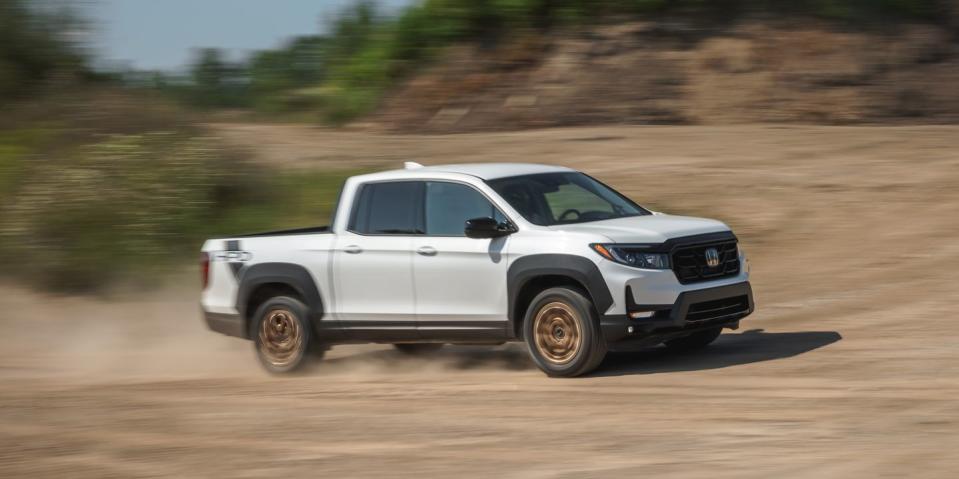
UPDATE 9/24/21: This review has been updated with test results.
Honda's Ridgeline has always worked well as a truck. Its towing and payload abilities fulfill most needs of the typical weekend warrior, and its unibody construction and independent rear suspension deliver the best on-pavement ride and handling in the business. But the Ridgeline doesn't look enough like other trucks. It rides too low, the nose is too stubby, and the cargo box comes in only one length, which aligns with other mid-size pickups' short bed option. Trucks from Ram, Toyota, Ford, Nissan, and General Motors all cast similarly shaped shadows. The Honda? Nope. It looks like a crossover that's halfway done morphing into a truck, and that screws with people's minds and expectations. For 2021, with the second-generation Ridgeline in its fourth year, Honda has decided to butch it up. Make it more trucky. More rugged. Tougher.
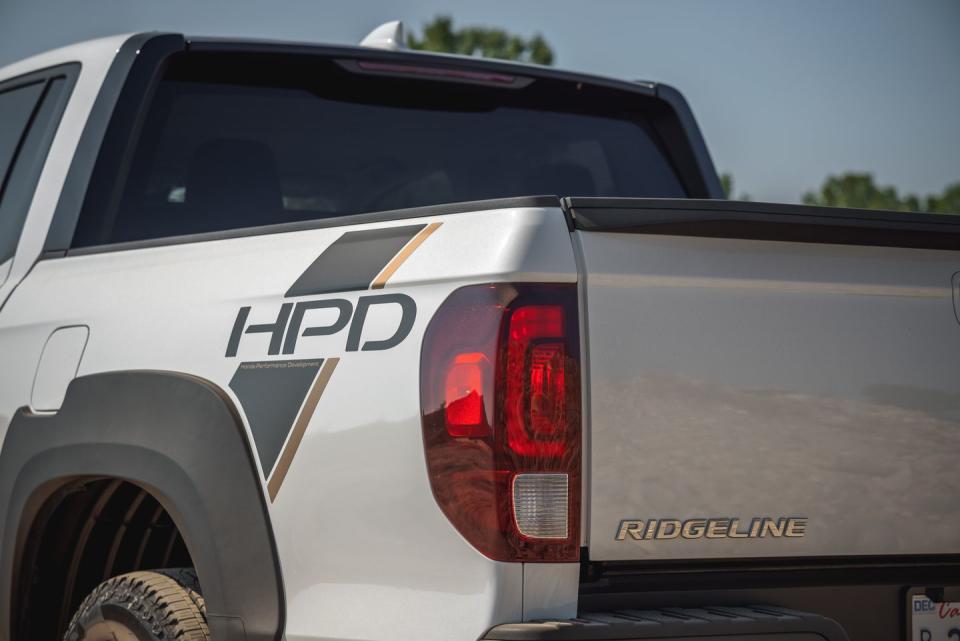
The leading edge of Honda's mucho-macho offensive is the new HPD package. HPD stands for Honda Performance Development, and it's part of Honda's push to create cachet (and profits) in the vein of what Toyota's done with the TRD brand. While Toyota's off-road heritage evokes jungle treks, African safaris, and United Nations disaster relief, Honda's history in the dirt is intertwined with motocross bikes, Trail 70s, and ATVs. Honda has campaigned a Ridgeline race truck in Baja, but they've still got work to do translating their powersports off-road cred to the automotive side.
All the 2021 Ridgelines get new, taller sheetmetal forward of the A-pillar, with new headlights and a blunter grille. As with most other trucks, that big grille is heavy-hauler cosplay, hinting at massive cooling and air-intake needs. Most of it, however, maybe two thirds of the surface area, is actually blocked off. Only the bottom part is open and allows air to flow through it; much of the air passing into the engine bay enters from beneath the bumper.
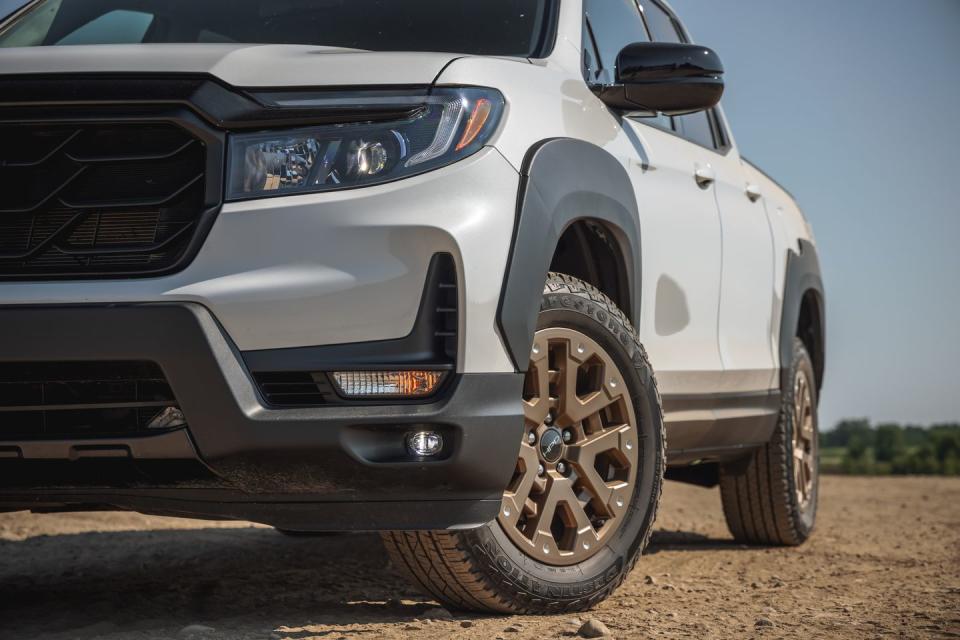
Functionally, all Ridgelines now get standard all-wheel drive and new 18-inch wheels that increase the track width by 0.8 inch. Inside there's now a volume knob planted at a corner of the high-mounted center touchscreen. We're at a strange place when we herald the addition of a volume knob as an important ergonomic innovation, but companies need positive reinforcement when they take this seemingly obvious step. So, good job on that, Honda!
For $2800, the HPD package includes black fender flares, its own unique grille, specific bronze-colored wheels, and HPD graphics. If the HPD package looks like a bolt-on accessory kit—the driver's side rear fender flare has a cutout for the gas-cap door—that's because it is. It's one of four new post-production packages that mostly include the usual truck accoutrements—running boards, a hard cover for the bed, roof rails, and crossbars. Notably, the HPD package doesn't bring any suspension or powertrain changes. It exists to help address the Ridgeline's biggest challenge: its image.
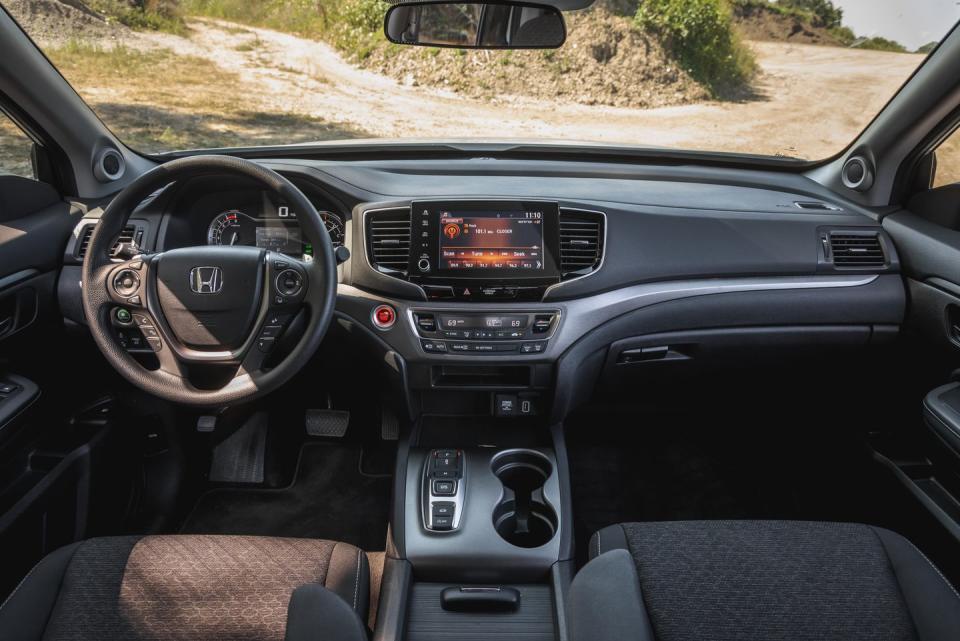
The HPD treatment is available on all Ridgeline trim levels from the base Sport like our test truck, which starts at $37,715, up through the $43,645 RTL-E. It's even offered on the $45,145 Black Edition that orbits atop the line, but that seems like overkill. The Sport, with its cloth upholstery and unpretentious decoration, meshes well with the HPD stuff and at $40,910 total, represents good value in comparison with the competition.
The Ridgeline continues to be, by far, the most comfortable mid-size truck for on-road use. The independent suspension bolted to its unibody structure is supple, confident, and easygoing. Road divots that can upset a stiff rock crawler such as the Tacoma TRD Pro are easily digested and overcome by the Ridgeline. The bouncy-tail happiness of some leaf-spring pickups is completely absent from this Honda, which can motor down the road at 70 mph with a hushed 67 decibels of noise penetrating its cabin. Put to more strenuous use at the test track, the Ridgeline circled the skidpad with a touch more grip than most mid-size trucks—0.79 g to be exact—and it stopped from 70 mph in a reasonable-for-a-pickup 186 feet.
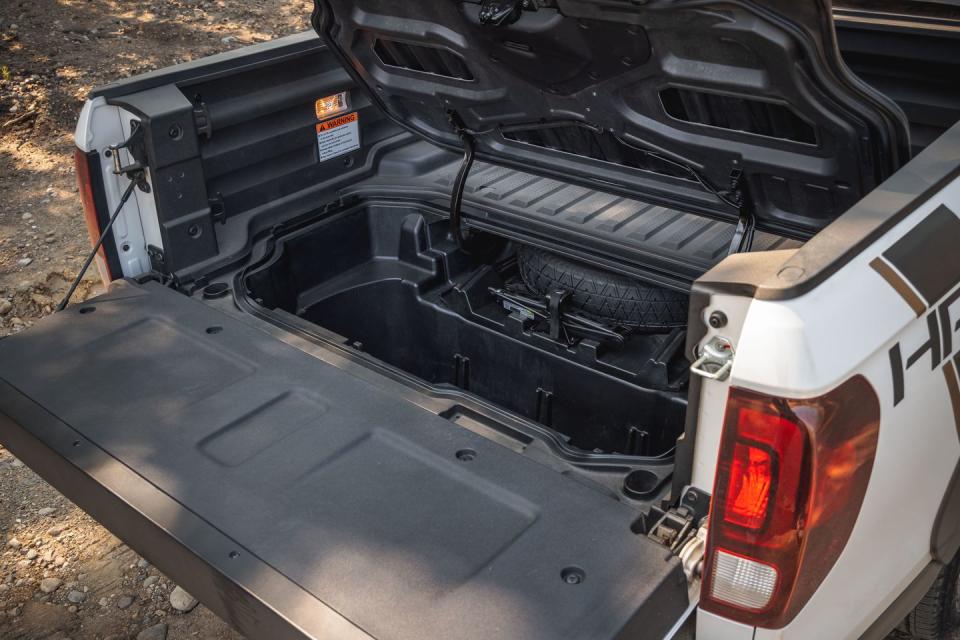
The Ridgeline continues to include a clever trunk hidden beneath the trailing edge of the tough composite bed. It's not just storage for Costco purchases; with a drain at the bottom, it'll work as a cooler. And with a two-way tailgate that swings down or sideways (the 1966 Ford Country Squire's great innovation, the Magic Doorgate), the Ridgeline is optimized for stadium-parking-lot dining. Besides the trunk and the trick tailgate, the Ridgeline also offers a truck-bed audio system in which the bed itself is enlisted as a giant speaker. GMC offers speakers in the tailgate, but Honda is the only one to use the bed itself to pump your jams.
Honda was eager to show off how capable the Ridgeline is off-road and brought a select group of journalists to its desert proving grounds to do that. Of course, the Ridgeline will handle virtually any situation most drivers will ever find themselves in. There's enough ground clearance and suspension articulation to handle surprisingly desperate situations. The three off-road drive modes—Snow, Mud, and Sand—optimize the throttle response, transmission, and all-wheel-drive system for particular conditions. Despite the Ridgeline's front-drive origins, it can send 70 percent of its torque to the rear and then 100 percent of that to either the right or left rear wheel. But there's no two-speed transfer case for crawling over boulders, mucking through deep sludge, or grinding across ridiculous dunes. Those are the exceptionally rare situations in which the body-on-frame trucks have an advantage. That said, we expect a future TrailSport model to meaningfully enhance the Ridgeline's off-road capability once Honda releases more details of its new rugged trim level.

The Ridgeline's engine remains the same transversely mounted 3.5-liter V-6 that Honda also plops into the truck's brothers, the Pilot and Passport crossovers and Odyssey minivan. It's rated at 280 horsepower and 262 pound-feet of torque, the latter peaking at a rather high 4700 rpm. It's a pleasant enough engine and does a good job propelling a vehicle that weighs in at 4469 pounds. More low-end torque would be appreciated, but the 3.5 V-6 is adequately adequate. A nine-speed automatic transmission replaced the previous six-speed unit for the 2020 model year and operates mostly in the background, though it responds quickly when you opt to use the column-mounted paddles behind the steering wheel.
We've tested a handful of second-gen Ridgelines, such as in this 2019 comparison test, where the Honda finished second, as well as a 40,000-mile long-term example. Thanks mostly to its upgraded transmission, the 2021 truck does the 60-mph dash in 6.2 seconds, which is a solid 0.7 second quicker than our long-termer could manage. The quarter-mile passes in 15.0 seconds at 93 mph, yet we also were able to coax 26 mpg out of our test truck on our 75-mph highway test, a 2-mpg improvement over its EPA estimate.

The Ridgeline is at its best when it's tasked with the boring chores most of us do most of the time. Yes, it can haul more than 1500 pounds in its bed and tow 5000 pounds. Great. But usually, our trucks are tasked with far less than full loads and maxed-out trailers. And that's where the Ridgeline shines. It's a great daily companion and weekend lifestyle warrior.
Lately, buyers have been going for trucks that are literally too much for what they need. Ford F-150 Raptors, Ram 1500 TRXs, and Toyota Tacoma TRD Pros are all loads of fun within the context of serious off-roading. But they can be a chore doing daily duty. The Ridgeline is the opposite of that.
Still, it's about proportions, and the revised styling can't disguise the Ridgeline's transverse-engine overhang and a dash-to-axle ratio that evokes the Baja—the Subaru not the race. And until Honda changes the Ridgeline's silhouette so that it more closely resembles what buyers expect of a truck, it's likely not going to be accepted by traditional truck buyers. That's their loss.
You Might Also Like

 Yahoo Autos
Yahoo Autos 